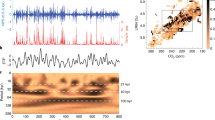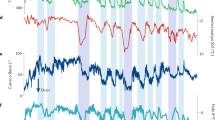Abstract
Climate in the early Pleistocene1 varied with a period of 41 kyr and was related to variations in Earth's obliquity. About 900 kyr ago, variability increased and oscillated primarily at a period of ∼100 kyr, suggesting that the link was then with the eccentricity of Earth's orbit. This transition has often2,3,4,5 been attributed to a nonlinear response to small changes in external boundary conditions. Here we propose that increasing variablility within the past million years may indicate that the climate system was approaching a second climate bifurcation point, after which it would transition again to a new stable state characterized by permanent mid-latitude Northern Hemisphere glaciation. From this perspective the past million years can be viewed as a transient interval in the evolution of Earth's climate. We support our hypothesis using a coupled energy-balance/ice-sheet model, which furthermore predicts that the future transition would involve a large expansion of the Eurasian ice sheet. The process responsible for the abrupt change seems to be the albedo discontinuity at the snow–ice edge. The best-fit model run, which explains almost 60% of the variance in global ice volume6 during the past 400 kyr, predicts a rapid transition in the geologically near future to the proposed glacial state. Should it be attained, this state would be more ‘symmetric’ than the present climate, with comparable areas of ice/sea-ice cover in each hemisphere, and would represent the culmination of 50 million years of evolution from bipolar nonglacial climates to bipolar glacial climates.
This is a preview of subscription content, access via your institution
Access options
Subscribe to this journal
Receive 51 print issues and online access
$199.00 per year
only $3.90 per issue
Buy this article
- Purchase on Springer Link
- Instant access to full article PDF
Prices may be subject to local taxes which are calculated during checkout





Similar content being viewed by others
References
Lisiecki, L. E. & Raymo, M. E. A Pliocene-Pleistocene stack of 57 globally distributed benthic δ18O records. Paleoceanography 20 doi: 10.1029/2004PA001071 (2005)
Maasch, K. & Saltzman, B. A low-order dynamical model of global climatic variability over the full Pleistocene. J. Geophys. Res. 95, 1955–1963 (1990)
Berger, A., Li, X. S. & Loutre, M.-F. Modeling northern hemisphere ice volume over the last three million years. Quat. Sci. Rev. 18, 1–11 (1999)
Huybers, P. Glacial variability over the last two million years: An extended depth-derived age model, continuous obliquity forcing, and the Pleistocene progression. Quat. Sci. Rev. 26, 37–55 (2007)
Lisiecki, L. & Raymo, M. E. Plio-Pleistocene climate evolution: Trends and transitions in glacial cycle dynamics. Quat. Sci. Rev. 26, 56–69 (2007)
Shackleton, N. J. The 100,000 year ice-age cycle identified and found to lag temperature, carbon dioxide, and orbital eccentricity. Science 289, 1897–1902 (2000)
McArthur, J. M., Howarth, R. J. & Bailey, T. R. Strontium isotope stratigraphy: LOWESS version 3: Best fit to the marine Sr-isotope curve for 0–509 Ma and accompanying look-up table for deriving numerical age. J. Geol. 109, 155–170 (2001)
Kukla, G. & Cilek, V. Plio-Pleistocene megacycles: Record of climate and tectonics. Palaeogeogr. Palaeoclimatol. Palaeoecol. 120, 171–194 (1996)
McManus, J. F., Oppo, D. W. & Cullen, J. L. A 0.5 million year record of millennial scale climate variability in the North Atlantic. Science 283, 971–975 (1999)
Crowley, T. J. & North, G. R. Abrupt climate change and extinction events in Earth history. Science 240, 996–1002 (1988)
Tarasov, L. & Peltier, W. R. Terminating the 100 kyr ice age cycle. J. Geophys. Res. 18, 21665–21693 (1997)
North, G. R., Mengel, J. G. & Short, D. A. Simple energy balance model resolving the seasons and the continents: Application to the astronomical theory of glaciation. J. Geophys. Res. 88, 6576–6586 (1983)
Hyde, W. T. & Crowley, T. J. Stochastic forcing of Pleistocene ice sheets: Implications for the origin of millennial-scale climate oscillations. Paleoceanography 17, 10.1029/2001PA000669 (2002)
Hyde, W. T., Crowley, T. J., Baum, S. K. & Peltier, W. R. Neoproterozoic ‘Snowball Earth’ simulations with a coupled climate/ice sheet model. Nature 405, 425–429 (2000)
Berger, A. Long term variations of daily insolation and Quaternary climate changes. J. Atmos. Sci. 35, 2362–2367 (1978)
Crowley, T. J. & Baum, S. K. Estimating Carboniferous sea-level fluctuations from Gondwanan ice extent. Geology 19, 975–977 (1991)
Calov, R. & Ganopolski, A. Multistability and hysteresis in the climate-cryosphere system under orbital forcing. Geophys. Res. Lett. 32 doi: 10.1029/2005GL024518 (2005)
van der Burgh, J., Visscher, H., Dilcher, D. L. & Kurschner, W. M. Paleoatmospheric signatures in Neogene fossil leaves. Science 260, 1788–1790 (1993)
Hyde, W. T. & Peltier, W. R. Sensitivity experiments with a model of the ice age cycle: The response to harmonic forcing. J. Atmos. Sci. 42, 2170–2188 (1985)
Lüthi, D. et al. High-resolution carbon dioxide concentration record 650,000–800,000 years before present. Nature 453, 379–382 (2008)
Budyko, M. I. The effect of solar radiation changes on the climate of the Earth. Tellus 21, 611–619 (1969)
North, G. R. The small ice cap instability in diffusive climate models. J. Atmos. Sci. 41, 3390–3395 (1984)
Hansen, J. E. & Lebedeff, S. Global trends of measured surface air temperature. J. Geophys. Res. 92, 13345–13372 (1987)
Manabe, S. & Broccoli, A. J. The influence of continental ice sheets on the climate of an ice age. J. Geophys. Res. 90, 2167–2190 (1985)
Crowley, T. J., Yip, K.-Y. J. & Baum, S. K. Snowline instability in a general circulation model: Application to Carboniferous glaciation. Clim. Dyn. 10, 363–374 (1994)
Baum, S. K. & Crowley, T. J. The snow/ice instability as a mechanism for rapid climate change: A Neoproterozoic Snowball Earth model example. Geophys. Res. Lett. 30 doi: 10.1029/2003GL017333 (2003)
Crowley, T. J., Hyde, W. T. & Baum, S. K. CO2 levels required for deglaciation of a “Near-Snowball” Earth. Geophys. Res. Lett. 28, 283–286 (2001)
DeConto, R. M. & Pollard, D. Rapid Cenozoic glaciation of Antarctica induced by declining atmospheric CO2 . Nature 421, 245–249 (2003)
Zachos, J., Pagani, M., Sloan, L., Thomas, E. & Billups, K. Trends, rhythms, and aberrations in global climate, 65 Ma to Present. Science 292, 686–693 (2001)
Jamieson, S. S. R. & Sugden, D. E. in Antarctica: A Keystone in a Changing World (eds Cooper, A. K. & Raymond, C.) 39–54 (Proc. 10th Intl Symp. Antarctic Earth Sci., National Academies, 2008)
Acknowledgements
This research received partial support the Scottish Alliance for Geoscience, the Environment, and Society (SAGES) and from the US National Science Foundation. We thank G. North for numerous discussions over the years and S. Obrochta for valuable assistance.
Author Contributions W.T.H. had primary responsibility for model simulations and T.J.C. for analysis of model output, comparison with geological data and write-up of results.
Author information
Authors and Affiliations
Corresponding author
Supplementary information
Supplementary Information 1
This file contains Supplementary Figures 1 and 2 with Legends (PDF 60 kb)
Supplementary Information 2
This file contains data for Spectral Analyses (TXT 163 kb)
Rights and permissions
About this article
Cite this article
Crowley, T., Hyde, W. Transient nature of late Pleistocene climate variability. Nature 456, 226–230 (2008). https://doi.org/10.1038/nature07365
Received:
Accepted:
Issue Date:
DOI: https://doi.org/10.1038/nature07365
This article is cited by
-
Functional clustering of varved lake sediment to reconstruct past seasonal climate
Environmental and Ecological Statistics (2016)
-
Inherent characteristics of sawtooth cycles can explain different glacial periodicities
Climate Dynamics (2016)
-
Patterns and mechanisms of early Pliocene warmth
Nature (2013)
-
Early-warning signals for critical transitions
Nature (2009)
Comments
By submitting a comment you agree to abide by our Terms and Community Guidelines. If you find something abusive or that does not comply with our terms or guidelines please flag it as inappropriate.



